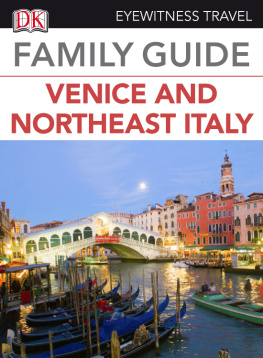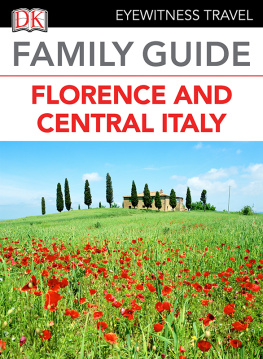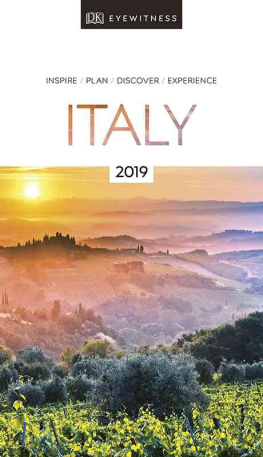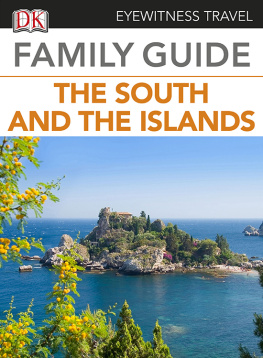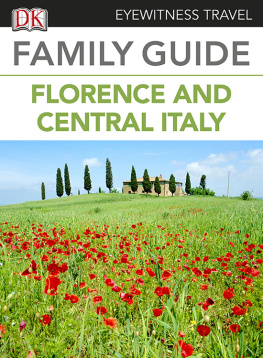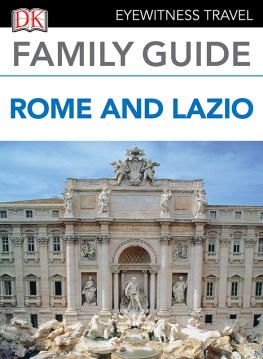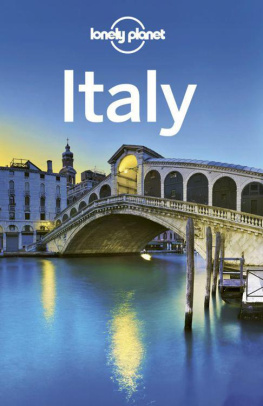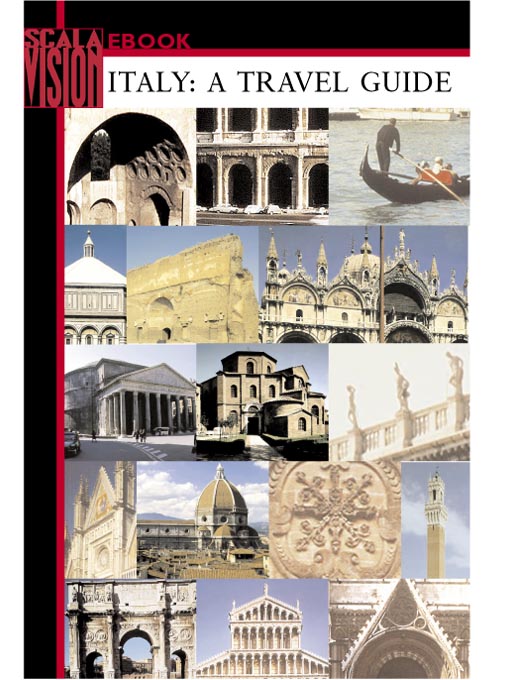FLORENCE
Florence is a proud city, a city of merchants and traders, a city of the unique age of the Renaissance. Walk through its streets and you will come across monuments that testify both to the extraordinary culture and art of the Quattrocento and to the period immediately preceding it, when Florence, together with its eternal rival Siena, became one of the main centers of trade and banking in Europe.
The great constructions of the fifteenth century were made possible by the enormous quantities of capital accumulated by Florentine merchants in the thirteenth and fourteenth century. The city's most important families had built up a network of trade that covered the principal cities of the known world, from Bruges to Malta, and from Constantinople to Marseilles. The Florentines traded chiefly in wool, but their ability to invent such modern commercial tools as double entry bookkeeping, the bill of exchange, and the incometax return rapidly transformed them into potent bankers. Their great economic success was made possible by the democratic government of the city. Florence was a republic for three centuries, until the Medici, the city's wealthiest and most powerful family of merchants, seized control and turned Florence into a seigniory.
PUBLIC BUILDINGS
Like all the cities of North and Central Italy, Florence experienced some major political ups and downs from the Middle Ages onward, marked by continual changes in the city's government. In the twelfth century, the city began to set up magistrates that were independent from the Holy Roman Empire, of which the city was still formally a part. Thus it was that Florence became a free city with republican political institutions, whose political and administrative center was formed by the Palazzo della Signoria, the square in front of it, the Loggia della Signoria, and the Palazzo della Signoria or Bargello.
BARGELLO
The Palazzo del Capitano (Bargello) was the first public building in the city. Erected in the thirteenth century as the seat for the Capitano del Popolo, or commander of the local militia, a post that represented the first democratic magistrate of the Middle Ages. The solid bulk of the building is enlivened by a soaring tower, that stands out from the surrounding spaces and holds a dialogue with the nearby campanile of the Abbey and Arnolfo di Cambio's Tower. In the courtyard of the Palazzo, each magistrate left a record of his passage with a coat of arms. Many of these can still be seen on the walls.
During the thirteenth century the city's political institutions changed. The Palazzo became known as the Bargello, after the name of the head of police to whom it was assigned. The Bargello soon attained a sad notoriety as a prison and place of execution for those who were condemned to death. Today it houses an important museum.
PALAZZO VECCHIO
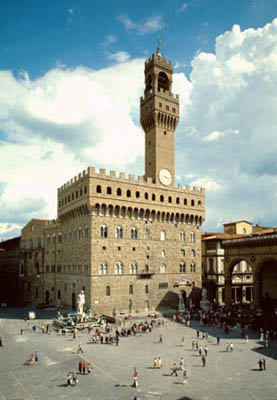
View of Palazzo Vecchio, Florence
In the fourteenth century, the city government was headed by figures known as Priors. The architect Arnolfo di Cambio built the Palazzo della Signoria for them, but it later acquired the name of Palazzo Vecchio to distinguish it from the other buildings erected to house the city authorities.
The appearance of the Palazzo is that of a castle with an austere facade, crowned by a projecting gallery decorated with battlements and by the tower, the tallest in the city. In the sixteenth century Cosimo I de' Medici and his wife Eleonora da Toledo took up residence there, and it was enlarged and enriched to make it worthy of its new inhabitants. For the wedding of their son Francesco I, the inner court was decorated with stuccoes, frescoes, and a fountain. The large Salone del Cinquecento, originally the seat of the city's supreme council, was turned into a place for the glorification of Cosimo I's military exploits, while he also had a small private study constructed to which he could retire for reflection. Called the Studiolo, it is a sort of precious casket filled with pictures, frescoes, and small bronzes by the best artists of the time.
Alongside the Palazzo della Signoria stands a vast loggia, or open gallery, erected as a place of assembly for the population when important decisions had to be taken. The Loggia della Signoria was later filled with statues.
In front of the Palazzo and the Loggia della Signoria extends a large square, the hub of the city and the stage for festivals and other important events in the city's history. It was here that the Dominican friar Girolamo Savonarola was burned in 1498. Scathing critic of the morals of the day and of Medicean power, his inspiration was to lead to the establishment of a more democratic republic.
PRIVATE BUILDINGS
Florence had been a republic with democratic political institutions that were among the most advanced in Europe, but in the fifteenth century it was gradually transformed into a rigid oligarchy. Control of the city was in the hands of the wealthiest families of merchants, such as the Pazzi, Strozzi, and Medici, who wanted to build residences more worthy of their new social role, abandoning the earlier model of the small, dark, and turreted building. From this desire sprang the magnificent palaces that altered the medieval appearance of the city, giving it its new, Renaissance guise.
PALAZZO DAVANZATI
The structure of the fourteenth-century Palazzo Davanzati provides a clear demonstration of the transition between the buildings of the Middle Ages and the residences of the Renaissance. The palace's facade still has a strongly vertical character, reminiscent of the structure of the tower houses. The layout of the court is also medieval, but there are already large windows on the first floor, and at the top the palazzo is concluded by an airy loggia of the sixteenth century. The interior of the palazzo is a perfect reconstruction of a Florentine residence of the Renaissance, with original furniture, paintings, statues, objects, and utensils from the period.
PALAZZO MEDICI
Cosimo de' Medici, founder of the famous family, was the first of the new potentates to build himself an urban residence in keeping with the wealth and noble status he had attained. The first commission was given to Brunelleschi, but his design was considered too sumptuous and suited to a king rather than to a merchant. Cosimo turned to Michelozzo, who designed and built a square plan building, Palazzo Medici on via Larga.
The lower part of the facades of the building is covered with rustication while the upper is pierced by elegant mullioned windows with two lights. Inside the spaces are arranged around the classical court, decorated with bas-reliefs from the school of Donatello. One of the treasures of Palazzo Medici is the Chapel of the Magi, frescoed in its entirety by Benozzo Gozzoli. The large-scale decoration represents the Magi riding toward Bethlehem, but the figures, depicted in Renaissance dress, are often portraits of Cosimo's contemporaries. The painter also put in figures of animals, including a number of exotic ones, for the delight of the children of the Medici family.
PALAZZO RUCELLAI
One of the most famous of humanist architects, Leon Battista Alberti, was the designer of the beautiful Palazzo Rucellai, a masterpiece of elegance and refinement. The Rucellai were a rich family of merchants who had accumulated an immense fortune through the discovery of a plant, archil, that, treated with urine, yielded a magnificent red dye for fabrics.



